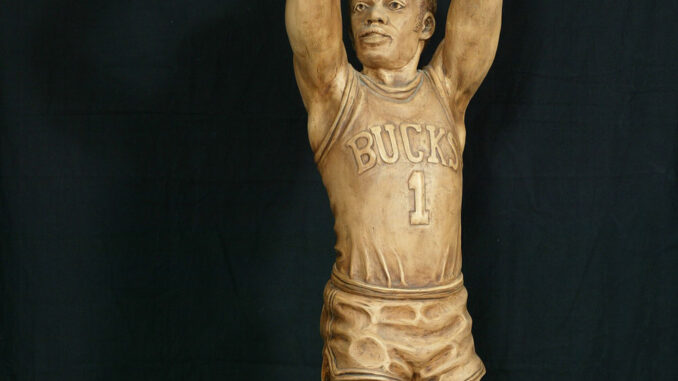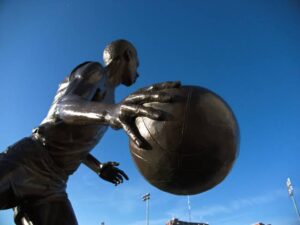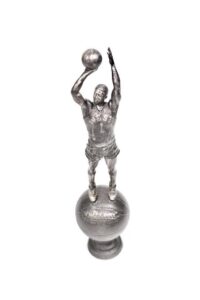
Special Report: Indiana Pacers Unveil Bronze Statue Honoring the Late Oscar Robertson – A Monument to Greatness.
*Indianapolis, IN – July 4, 2025* — In a moving ceremony attended by family, fans, and basketball legends, the Indiana Pacers unveiled a magnificent bronze statue of the late Oscar Robertson, one of the most iconic and pioneering figures in basketball history. Erected outside Gainbridge Fieldhouse, the home of the Pacers, the tribute marks a permanent reminder of Robertson’s unparalleled legacy and lasting contributions to the game, the state of Indiana, and American sports culture at large.
Known affectionately as “The Big O,” Oscar Robertson is widely regarded as one of the greatest players to ever grace a basketball court. Though he never played for the Indiana Pacers professionally, his deep roots in Indiana—as a native son, high school legend, collegiate star, and trailblazer—cemented his place as a cultural cornerstone of the state’s basketball identity. His influence shaped generations of athletes, and his legacy still resonates today.
—
### **A Historic Day in Indiana Basketball**
Thousands gathered outside Gainbridge Fieldhouse on a sunny Friday morning to witness the statue’s unveiling. Attendees included NBA Commissioner Adam Silver, Pacers President Kevin Pritchard, Indiana Governor Eric Holcomb, and representatives from the NBA Players Association. Robertson’s family members—his widow Yvonne, daughters Tia and Sheri, and several grandchildren—stood solemnly by as the cover was lifted off the life-size statue, revealing a powerful likeness of Robertson in his prime, poised in a signature passing stance, a basketball cradled in one hand and his eyes fixed toward the future.
Applause erupted as the bronze glistened under the morning sun, reflecting the admiration of a community forever grateful for Robertson’s contributions on and off the court.
“This statue is more than a tribute to Oscar’s greatness as an athlete,” said Governor Holcomb. “It’s a symbol of perseverance, integrity, and the power of dreams. He changed the game, and in many ways, he changed America.”
—
### **Legacy of Excellence**
Born in Charlotte, Tennessee, and raised in Indianapolis, Oscar Robertson grew up during a time of profound racial and social inequality. He rose to stardom at Crispus Attucks High School, leading the team to back-to-back state championships in 1955 and 1956—the first all-Black team to win an Indiana state title. The victories shattered barriers and inspired countless young athletes across the nation.
Robertson’s collegiate career at the University of Cincinnati was equally historic. He averaged a staggering 33.8 points per game over three seasons and won the national player of the year award each year—yet still faced discrimination both on and off the court. Despite that, he carried himself with poise, dignity, and unshakeable determination.
In the NBA, Robertson’s achievements were nothing short of revolutionary. Playing primarily for the Cincinnati Royals and later the Milwaukee Bucks, he became the first player to average a triple-double over an entire season—a feat thought to be impossible at the time. He was a 12-time All-Star, an MVP, and won an NBA championship with the Bucks in 1971 alongside Kareem Abdul-Jabbar.
But Robertson’s impact extended far beyond statistics. In 1970, as president of the National Basketball Players Association, he filed a landmark antitrust lawsuit against the NBA, leading to the establishment of free agency and reshaping the economics of professional sports. The case, famously known as the “Oscar Robertson suit,” was settled in 1976 and remains one of the most influential legal actions in sports labor history.
—
### **A Family and Community Man**
Despite his towering success, Oscar Robertson never forgot where he came from. He remained deeply connected to Indiana and consistently gave back to the community. He funded scholarships, mentored young athletes, and supported educational programs throughout the state. He also led several public health and kidney disease awareness campaigns following his daughter Tia’s life-saving kidney transplant, for which he was the donor.
“My father wasn’t just a great basketball player—he was a great man,” said Sheri Robertson, holding back tears. “He believed in fairness, he fought for others, and he always reminded us that the game was only part of the story. His real victories were the lives he helped change.”
—
### **The Making of the Statue**
The statue was commissioned by the Indiana Pacers organization in collaboration with the Robertson family, and sculpted by renowned artist Julie Rotblatt-Amrany, whose previous works include monuments to Michael Jordan and Shaquille O’Neal. The creation process took over a year and included extensive research into Robertson’s posture, physique, and demeanor.
“I wanted to capture Oscar in motion,” said Rotblatt-Amrany. “He was known for his court vision and his ability to control the game. That’s why he’s holding the ball the way he is in the statue—not shooting, not dribbling, but scanning, thinking, leading. That’s the essence of who he was.”
The statue’s base is inscribed with one of Robertson’s most memorable quotes: *“Winning is about having the whole team on the same page.”* Surrounding the base are plaques chronicling his high school, college, and NBA accomplishments, as well as his contributions to civil rights and player advocacy.
—
### **A Lasting Legacy**
While Oscar Robertson passed away peacefully in December 2024 at the age of 86, his presence was undeniably felt throughout the ceremony. His legacy, immortalized in bronze, now stands in the heart of the city where his basketball journey began.
NBA Commissioner Adam Silver summed it up best during his remarks: “Oscar Robertson was not just ahead of his time—he helped define it. Without Oscar, there would be no modern NBA as we know it. This statue is a testament to his courage, leadership, and vision.”
Fans lingered long after the official ceremony, many laying flowers at the base of the statue or simply gazing up, lost in thought. Young children posed for pictures while older generations shared stories of watching the legend play.
For the Pacers organization and the city of Indianapolis, the monument is more than a memorial—it is a beacon of inspiration.
—
### **Conclusion**
In honoring Oscar Robertson with a statue outside Gainbridge Fieldhouse, the Indiana Pacers have etched a permanent symbol of excellence into the foundation of their franchise and the fabric of their community. More than just a basketball hero, Robertson was a leader, an advocate, and a symbol of progress whose story continues to resonate far beyond the hardwood.
As the bronze figure watches over the entrance to the arena, generations of fans and players alike will be reminded of what is possible—when talent, heart, and courage come together.
A legend has been immortalized. The Big O lives on.


Leave a Reply